Lpiyre.com (Simple Removal Guide) - Free Instructions
Lpiyre.com Removal Guide
What is Lpiyre.com?
Lpiyre.com – a hazardous website that shows misleading prompts
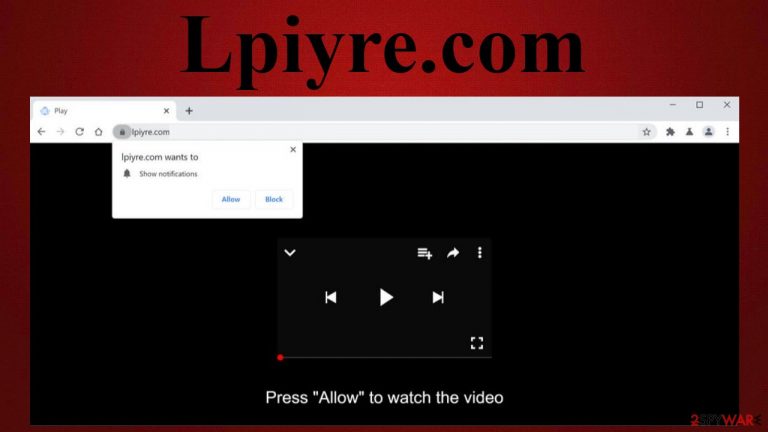
Lpiyre.com is a push notification virus portal that tries to trick its visitors into accepting notifications. It does that by showing deceptive page backgrounds and prompts suggesting that pushing the Allow button will prove that you're not a robot, confirm that you're over 18, continue to the website, download a file, etc.
In fact, if you enable notifications on this treacherous site, you start receiving ads. They will come in the form of notifications and appear directly on your phone screen or computer desktop. In some cases, they're impossible to close, as pressing the “X” button either opens a new tab with an affiliated page or does nothing at all.
If you didn't type in the culprit's address manually or push on any ads on shady websites, you might be forced to visit Lpiyre.com because of an adware or other potentially unwanted program[1] (PUP) infection. By reading this article, you'll find out how to remove any PUPs and get rid of the annoying ads.
| name | Lpiyre.com |
|---|---|
| type | PUP, adware, redirect virus |
| IP address | 185.56.234.205 |
| Purpose | Trick users into accepting notifications to show them ads and redirect to affiliated pages |
| Symptoms | Suspicious ads popping up directly on the screen or in the top-right or bottom-right corners of the desktop; decrease device performance; new tabs with questionable websites open out of the blue |
| Risks | Malware infections, identity theft, monetary losses |
| Distribution | Freeware, software bundles, deceptive ads, fake Flash Player updates |
| Elimination | Trustworthy anti-malware software should be trusted with any cyber threat removal as only then it's properly terminated |
| System health check | PUPs and other infections can alter system directories resulting in decreased performance, crashes, and similar system failures. You can repair system irregularities by running a full system scan with the FortectIntego system diagnostics tool |
There are tons of push notification virus websites, such as Revercecaptcha.com, Forlumineontor.com, Spination.top, etc., and new ones are created daily. They're developed to generate revenue for their creators by redirecting users to affiliated websites. That's done in two ways:
- Showing deceptive ads in the form of notifications
- and causing sudden redirects where a new browser window or tab is opened with sponsored content.
Lpiyre.com ads might be alluring by offering amazing deals, discounts, coupons, free cash, and so on. But please be advised that if you click on any of them, you will be redirected to pages that have nothing in common with the displayed ads.
Usually, potentially unwanted program developers advertise each other or similar shady, questionable, or even malicious pages. That's why you could be redirected to sites with various scams, PUPs, porn, malware, gambling, other push notification viruses, etc.
What's even more disturbing, you might be forced to visit any of the affiliated portals without even clicking on anything. That could happen if a sudden redirect is triggered, and that can be done on demand. Thus you're better of not accepting Lpiyre.com notifications.
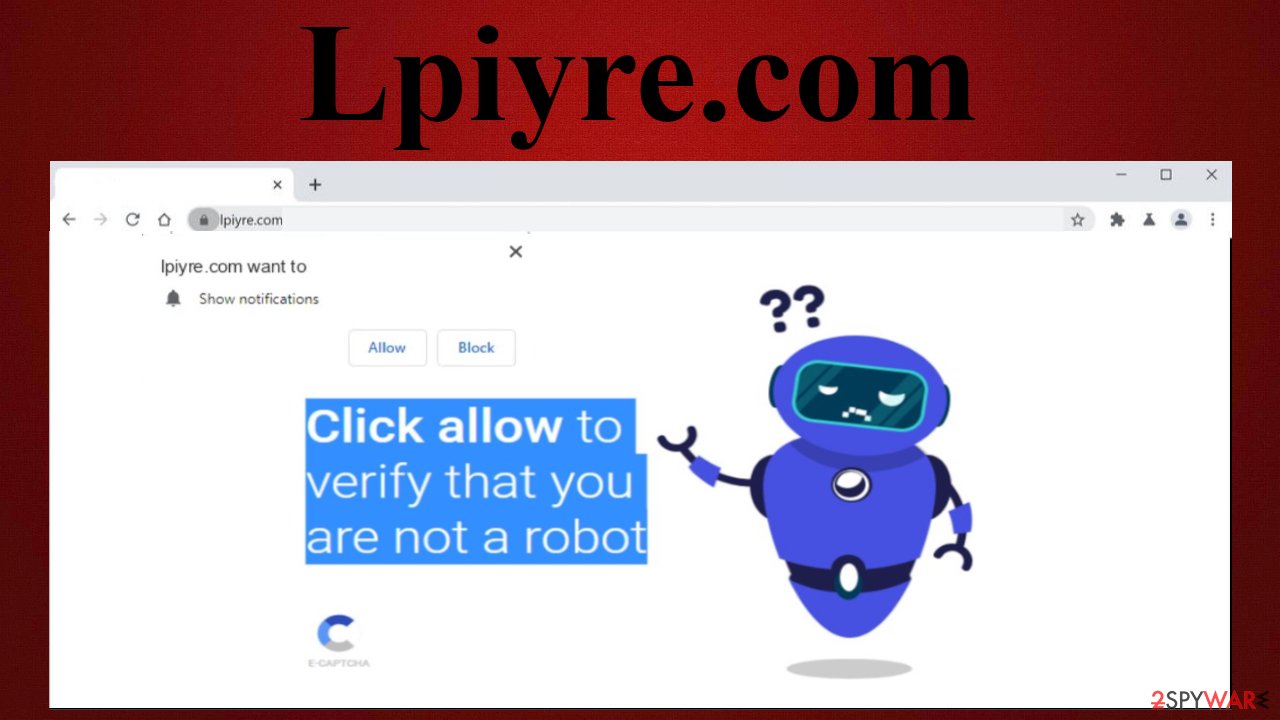
If you already did, then use our removal instructions posted at the bottom of this article. But be sure to scan your device with trusty anti-malware software to stay assured that there's no adware or malware. If you don't own a proper AV tool, download Malwarebytes or SpyHunter 5Combo Cleaner. These free security tools will remove all cyber threats and keep your device protected.
Afterward, a system tune-up is in order to restore any changes the infection has made to your system files and settings. IT experts[2] highly recommend entrusting this task to the time-proven FortectIntego system diagnostics tool as it will take care of all system irregularities automatically so you could enjoy your device anew.
Fake Flash Player updates are responsible for tons of PUP infections
Flash Player support was discontinued on December 31, 2020, but many people still don't know that. Cybercriminals exploit this by showing deceptive prompts and ads that suggest that you need to update or install this software. Such prompts are usually seen on various shady or hacked websites.
If you download and install the suggested update, your device in use will be immediately infected. The range of infection can vary from pesky and annoying adware, or a browser hijacker, to severe malware, such as Trojans, keyloggers, ransomware, etc.
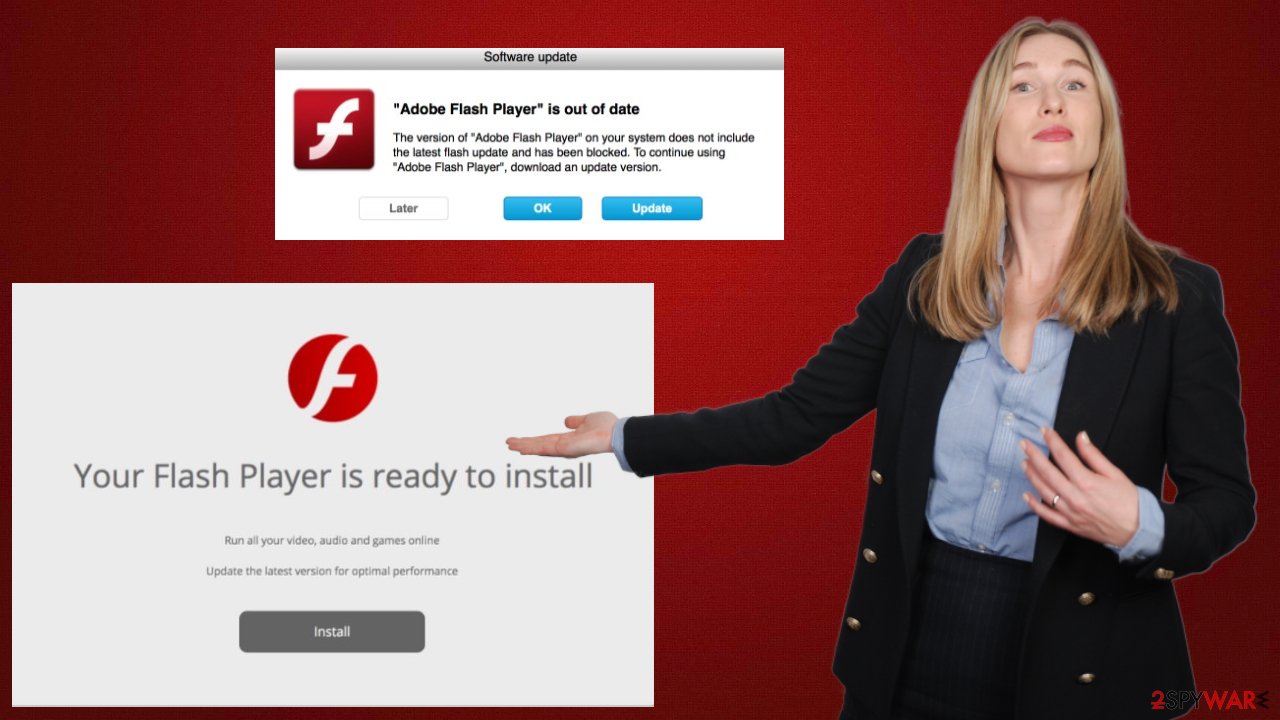
If you ever encounter a prompt/ad that claims that your Flash Player is out of date, please immediately close the tab, clear your browsing history, and never visit that site again. If it showed deceptive ads, it might instantly infect your device with malware via drive-by downloads[3] the next time.
Free instructions to help you remove Lpiyre.com notifications from your browser and device
Push notification is a great service that helps people get the latest news, deals, sports updates, and other info directly to their screen, unlike Lpiyre.com virus, which will bombard you with ads. Thus please accept notifications only from legitimate sources that you frequently visit and trust.
First, you have to eliminate the adware that caused the initial redirect to the treacherous page to begin the removal process. It could be camouflaged as any app, so the most effective way to remove it is by scanning your device with a trustworthy anti-malware tool.
If you've pressed the Allow button on Lpiyre.com, use our free guides below to remove its notifications. For your convenience, we've included instructions for Chrome, Safari, and other browsers. Lastly, finish the removal by running system diagnostics with compatible software to ensure your device runs smoothly.
You may remove virus damage with a help of FortectIntego. SpyHunter 5Combo Cleaner and Malwarebytes are recommended to detect potentially unwanted programs and viruses with all their files and registry entries that are related to them.
Getting rid of Lpiyre.com. Follow these steps
Stop browser notifications
Remove unwanted notifications from Google Chrome (desktop):
- Open Google Chrome browser and go to Menu > Settings.
- Scroll down and click on Advanced.
- Locate Privacy and security section and pick Site Settings > Notifications.

- Look at the Allow section and look for a suspicious URL.
- Click the three vertical dots next to it and pick Block. This should remove unwanted notifications from Google Chrome.

Remove unwanted notifications from Google Chrome (Android):
- Open Google Chrome and tap on Settings (three vertical dots).
- Select Notifications.
- Scroll down to the Sites section.
- Locate the unwanted URL and toggle the button to the left (Off setting).

Remove unwanted notifications from Mozilla Firefox:
- Open Mozilla Firefox and go to Menu > Options.
- Click on Privacy & Security section.
- Under Permissions, you should be able to see Notifications. Click the Settings button next to it.

- In the Settings – Notification Permissions window, click on the drop-down menu by the URL in question.
- Select Block and then click on Save Changes. This should remove unwanted notifications from Mozilla Firefox.

Remove unwanted notifications from Safari:
- Click on Safari > Preferences…
- Go to the Websites tab and, under General, select Notifications.
- Select the web address in question, click the drop-down menu and select Deny.

Remove unwanted notifications from MS Edge:
- Open Microsoft Edge, and click the Settings and more button (three horizontal dots) at the top-right of the window.
- Select Settings and then go to Advanced.
- Under Website permissions, pick Manage permissions and select the URL in question.

- Toggle the switch to the left to turn notifications off on Microsoft Edge.

Remove unwanted notifications from MS Edge (Chromium):
- Open Microsoft Edge, and go to Settings.
- Select Site permissions.
- Go to Notifications on the right.
- Under Allow, you will find the unwanted entry.
- Click on More actions and select Block.

Remove unwanted notifications from Internet Explorer:
- Open Internet Explorer, and click on the Gear icon at the top-right of the window.
- Select Internet options and go to the Privacy tab.
- In the Pop-up Blocker section, click on Settings.
- Locate web address in question under Allowed sites and pick Remove.

Uninstall from Windows
Instructions for Windows 10/8 machines:
- Enter Control Panel into Windows search box and hit Enter or click on the search result.
- Under Programs, select Uninstall a program.

- From the list, find the entry of the suspicious program.
- Right-click on the application and select Uninstall.
- If User Account Control shows up, click Yes.
- Wait till uninstallation process is complete and click OK.

If you are Windows 7/XP user, proceed with the following instructions:
- Click on Windows Start > Control Panel located on the right pane (if you are Windows XP user, click on Add/Remove Programs).
- In Control Panel, select Programs > Uninstall a program.

- Pick the unwanted application by clicking on it once.
- At the top, click Uninstall/Change.
- In the confirmation prompt, pick Yes.
- Click OK once the removal process is finished.
Delete from macOS
Remove items from Applications folder:
- From the menu bar, select Go > Applications.
- In the Applications folder, look for all related entries.
- Click on the app and drag it to Trash (or right-click and pick Move to Trash)

To fully remove an unwanted app, you need to access Application Support, LaunchAgents, and LaunchDaemons folders and delete relevant files:
- Select Go > Go to Folder.
- Enter /Library/Application Support and click Go or press Enter.
- In the Application Support folder, look for any dubious entries and then delete them.
- Now enter /Library/LaunchAgents and /Library/LaunchDaemons folders the same way and terminate all the related .plist files.

Uninstall from Android
Uninstall unwanted programs from Android device:
- Go to Settings -> Apps/Applications.
- Expand the full list of the installed apps.
- Scroll through the list and tap on a suspicious application once.
- Tap on it and select Uninstall.
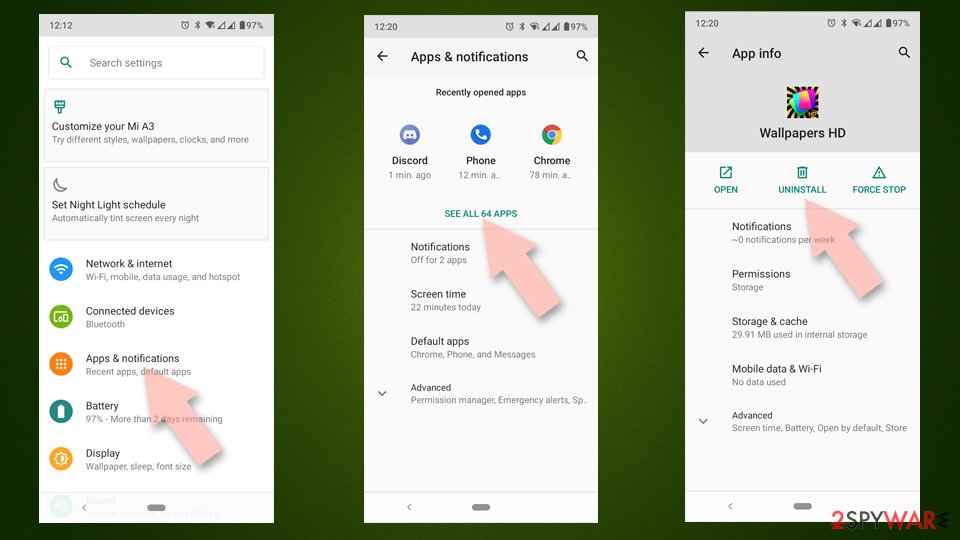
- Reboot the device.
Clear Storage and data files on Android from Google Chrome or other apps:
- Go to Settings > Apps/Applications.
- Expand the full list of the installed apps.
- Tap on Chrome and select Storage & cache.
- Clear storage and clear cache of the app.
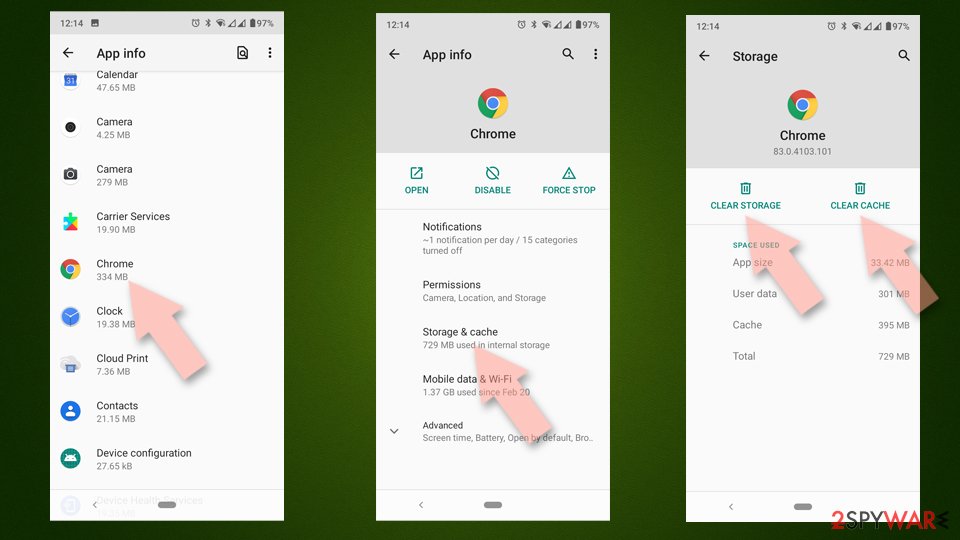
If you are seeing ads on top of other apps but are not sure what is causing it, perform the following steps:
- Go to Apps/Applications.
- Tap Advanced.
- Select Special App access.
- Tap on Display over other apps.
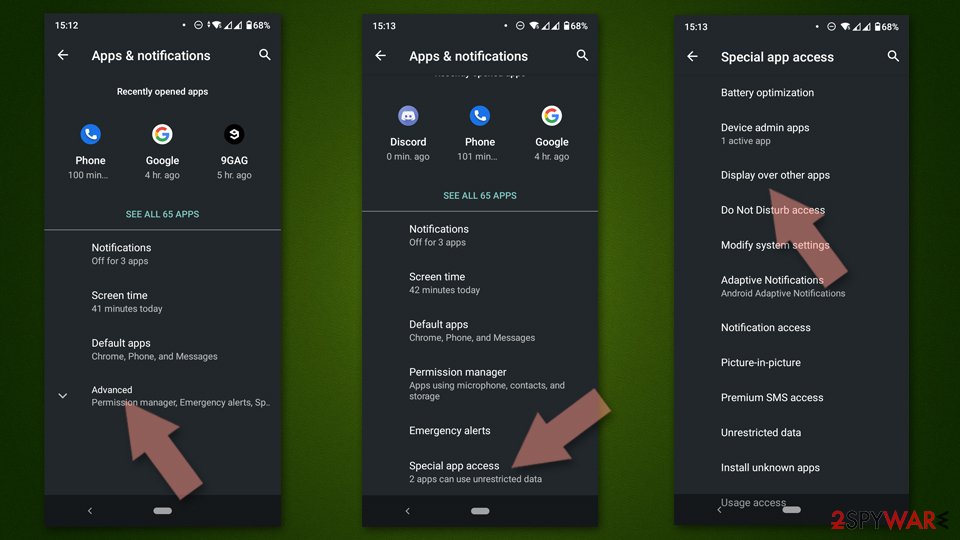
- Eliminate apps with these access rights enabled.
Remove from Microsoft Edge
Delete unwanted extensions from MS Edge:
- Select Menu (three horizontal dots at the top-right of the browser window) and pick Extensions.
- From the list, pick the extension and click on the Gear icon.
- Click on Uninstall at the bottom.

Clear cookies and other browser data:
- Click on the Menu (three horizontal dots at the top-right of the browser window) and select Privacy & security.
- Under Clear browsing data, pick Choose what to clear.
- Select everything (apart from passwords, although you might want to include Media licenses as well, if applicable) and click on Clear.

Restore new tab and homepage settings:
- Click the menu icon and choose Settings.
- Then find On startup section.
- Click Disable if you found any suspicious domain.
Reset MS Edge if the above steps did not work:
- Press on Ctrl + Shift + Esc to open Task Manager.
- Click on More details arrow at the bottom of the window.
- Select Details tab.
- Now scroll down and locate every entry with Microsoft Edge name in it. Right-click on each of them and select End Task to stop MS Edge from running.

If this solution failed to help you, you need to use an advanced Edge reset method. Note that you need to backup your data before proceeding.
- Find the following folder on your computer: C:\\Users\\%username%\\AppData\\Local\\Packages\\Microsoft.MicrosoftEdge_8wekyb3d8bbwe.
- Press Ctrl + A on your keyboard to select all folders.
- Right-click on them and pick Delete

- Now right-click on the Start button and pick Windows PowerShell (Admin).
- When the new window opens, copy and paste the following command, and then press Enter:
Get-AppXPackage -AllUsers -Name Microsoft.MicrosoftEdge | Foreach {Add-AppxPackage -DisableDevelopmentMode -Register “$($_.InstallLocation)\\AppXManifest.xml” -Verbose

Instructions for Chromium-based Edge
Delete extensions from MS Edge (Chromium):
- Open Edge and click select Settings > Extensions.
- Delete unwanted extensions by clicking Remove.

Clear cache and site data:
- Click on Menu and go to Settings.
- Select Privacy, search and services.
- Under Clear browsing data, pick Choose what to clear.
- Under Time range, pick All time.
- Select Clear now.

Reset Chromium-based MS Edge:
- Click on Menu and select Settings.
- On the left side, pick Reset settings.
- Select Restore settings to their default values.
- Confirm with Reset.

Remove from Mozilla Firefox (FF)
Remove dangerous extensions:
- Open Mozilla Firefox browser and click on the Menu (three horizontal lines at the top-right of the window).
- Select Add-ons.
- In here, select unwanted plugin and click Remove.

Reset the homepage:
- Click three horizontal lines at the top right corner to open the menu.
- Choose Options.
- Under Home options, enter your preferred site that will open every time you newly open the Mozilla Firefox.
Clear cookies and site data:
- Click Menu and pick Settings.
- Go to Privacy & Security section.
- Scroll down to locate Cookies and Site Data.
- Click on Clear Data…
- Select Cookies and Site Data, as well as Cached Web Content and press Clear.

Reset Mozilla Firefox
If clearing the browser as explained above did not help, reset Mozilla Firefox:
- Open Mozilla Firefox browser and click the Menu.
- Go to Help and then choose Troubleshooting Information.

- Under Give Firefox a tune up section, click on Refresh Firefox…
- Once the pop-up shows up, confirm the action by pressing on Refresh Firefox.

Remove from Google Chrome
Delete malicious extensions from Google Chrome:
- Open Google Chrome, click on the Menu (three vertical dots at the top-right corner) and select More tools > Extensions.
- In the newly opened window, you will see all the installed extensions. Uninstall all the suspicious plugins that might be related to the unwanted program by clicking Remove.

Clear cache and web data from Chrome:
- Click on Menu and pick Settings.
- Under Privacy and security, select Clear browsing data.
- Select Browsing history, Cookies and other site data, as well as Cached images and files.
- Click Clear data.

Change your homepage:
- Click menu and choose Settings.
- Look for a suspicious site in the On startup section.
- Click on Open a specific or set of pages and click on three dots to find the Remove option.
Reset Google Chrome:
If the previous methods did not help you, reset Google Chrome to eliminate all the unwanted components:
- Click on Menu and select Settings.
- In the Settings, scroll down and click Advanced.
- Scroll down and locate Reset and clean up section.
- Now click Restore settings to their original defaults.
- Confirm with Reset settings.

Delete from Safari
Remove unwanted extensions from Safari:
- Click Safari > Preferences…
- In the new window, pick Extensions.
- Select the unwanted extension and select Uninstall.

Clear cookies and other website data from Safari:
- Click Safari > Clear History…
- From the drop-down menu under Clear, pick all history.
- Confirm with Clear History.

Reset Safari if the above-mentioned steps did not help you:
- Click Safari > Preferences…
- Go to Advanced tab.
- Tick the Show Develop menu in menu bar.
- From the menu bar, click Develop, and then select Empty Caches.

After uninstalling this potentially unwanted program (PUP) and fixing each of your web browsers, we recommend you to scan your PC system with a reputable anti-spyware. This will help you to get rid of Lpiyre.com registry traces and will also identify related parasites or possible malware infections on your computer. For that you can use our top-rated malware remover: FortectIntego, SpyHunter 5Combo Cleaner or Malwarebytes.
How to prevent from getting adware
Stream videos without limitations, no matter where you are
There are multiple parties that could find out almost anything about you by checking your online activity. While this is highly unlikely, advertisers and tech companies are constantly tracking you online. The first step to privacy should be a secure browser that focuses on tracker reduction to a minimum.
Even if you employ a secure browser, you will not be able to access websites that are restricted due to local government laws or other reasons. In other words, you may not be able to stream Disney+ or US-based Netflix in some countries. To bypass these restrictions, you can employ a powerful Private Internet Access VPN, which provides dedicated servers for torrenting and streaming, not slowing you down in the process.
Data backups are important – recover your lost files
Ransomware is one of the biggest threats to personal data. Once it is executed on a machine, it launches a sophisticated encryption algorithm that locks all your files, although it does not destroy them. The most common misconception is that anti-malware software can return files to their previous states. This is not true, however, and data remains locked after the malicious payload is deleted.
While regular data backups are the only secure method to recover your files after a ransomware attack, tools such as Data Recovery Pro can also be effective and restore at least some of your lost data.
- ^ Potentially Unwanted Program (PUP). Techopedia. Professional it insights.
- ^ Udenvirus. Udenvirus. Spyware news and security.
- ^ Drive-by download. Wikipedia. The free encyclopedia.
